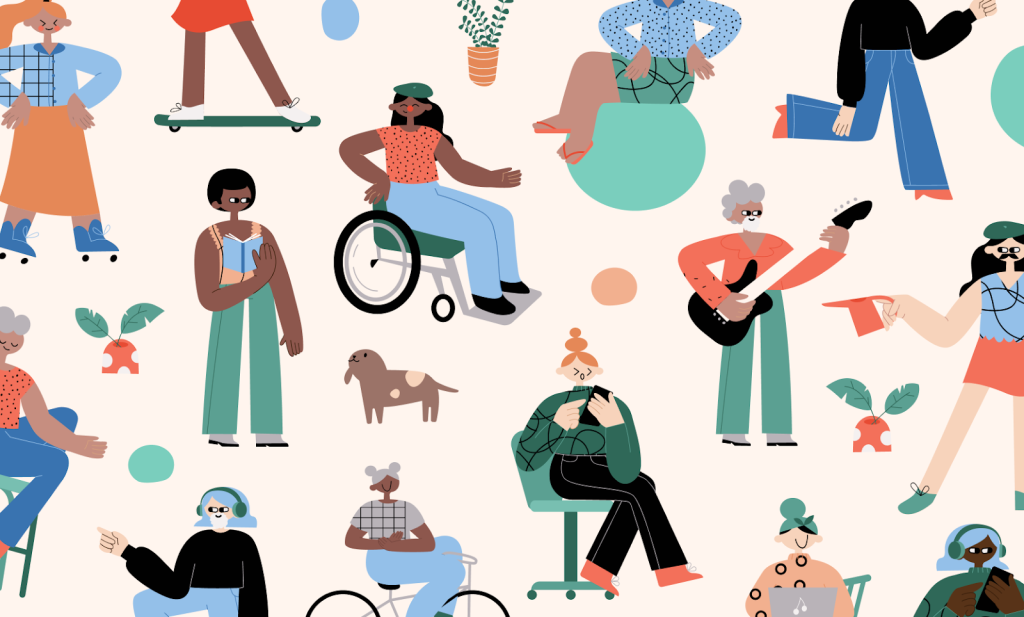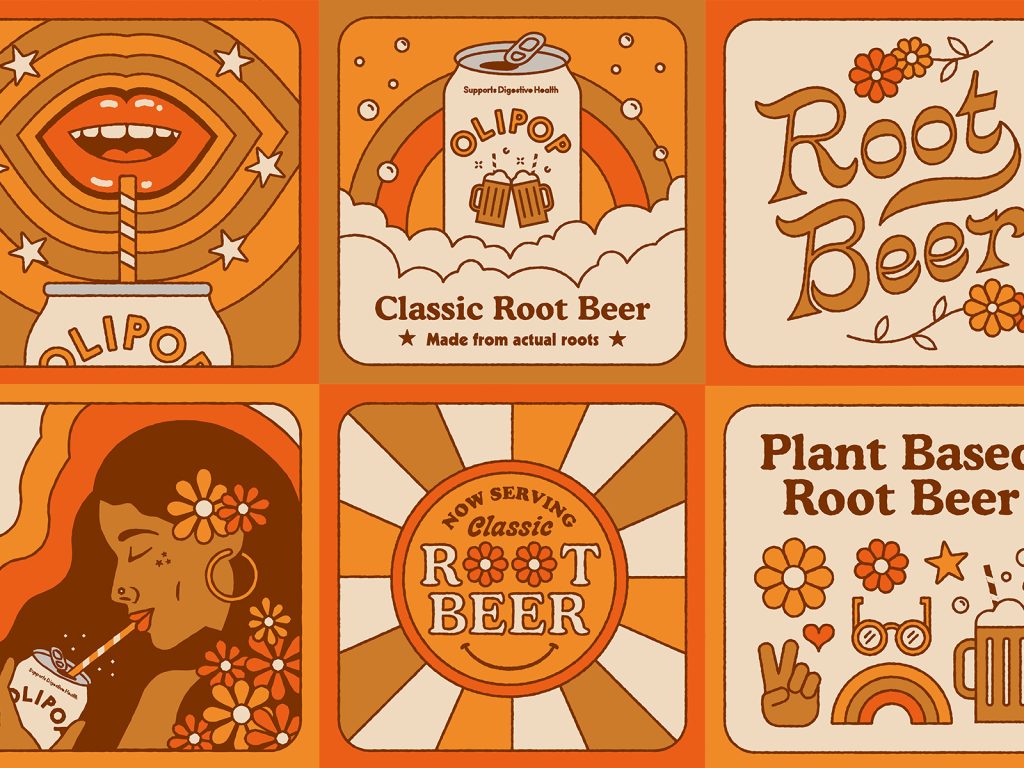
In the ever-evolving world of graphic design, understanding and recognizing the latest digital and print trends is essential for creating purposeful, modern designs.
Today’s graphic designers understand that trends are not just fleeting fads to follow—they reflect cultural shifts, technological advancements, and audience expectations. By keeping up with these changes, you, as a designer, can refine your creative vision and push the boundaries of your craft in new and exciting ways.
Of course, each year brings a fresh wave of trends influencing aesthetic preferences and reshaping how designers approach their work. In 2024, we are witnessing trends emphasizing diversity, inclusion, and representation as graphic design continues to be shaped by societal demands.
The rise of AI-powered design further transforms the landscape, providing designers with new tools and methodologies to explore and integrate into their work. As these trends permeate the industry, they continue to push the envelope and create new standards for cutting-edge design.
This year, designers are challenged to keep up with these rapid advancements, mainly as artificial intelligence generates new design possibilities at an almost unheard-of rate. From dynamic layouts to hyper-personalized content, these trends are reshaping what it means to produce meaningful and impactful designs. In this article, we will explore the most prominent graphic design trends of 2024, examining how they influence designers’ work and what they mean for the industry’s future.
What Does Artificial Intelligence Mean for Graphic Design Trends?

Before discussing the new graphic design trends, we must discuss the most significant change in the digital landscape: Artificial Intelligence (AI).
AI is revolutionizing the design landscape this year, reshaping creative processes and industry standards. AI-powered software and programs enable designers in different fields and experience levels to push boundaries unheard of.
AI has been accelerating innovation and fundamentally altering how design is approached. How exactly has AI done this? Let’s look at some specific ways AI changes and impacts graphic design.
AI-Driven Creativity

AI has the remarkable ability to analyze vast amounts of data, generating design solutions quickly.
As AI has started to take leaps and bounds with its advancements in software, more AI software, such as Adobe’s Sensei, Canvas AI assistant, and generative design platforms, have made it easier than ever for designers to automate mundane and time-consuming tasks.
AI can now do tasks such as resizing, formatting, and color matching while leaving more time for complex, high-level conceptual work. This enables designers to use their human creativity to focus more on curating high-quality and unique designs.
Generative Design and New Aesthetic Trends
AI has many superpowers, and one of their most significant is its ability to produce complex, intricate patterns that would be impossible or time-consuming for designers to create manually. These designs, influenced by AI’s ability to draw from vast datasets, push the boundaries of what is aesthetically possible.
The blend of human creativity with AI’s computational power leads to new, experimental design trends that combine abstract forms, dynamic layouts, and unexpected color palettes. AI has started to create new graphic design trends and can now generate designs that have begun to surprise even the most experienced graphic designers.
Ethical and Collaborative Considerations
The rise of AI in graphic design has also sparked essential discussions around ownership and the role of designers in a world increasingly influenced by algorithms. As AI continues to play a more significant role, designers must navigate the ethical implications of using AI-generated content.
Additionally, AI tools are increasingly collaborative, integrating seamlessly with other creative software, making it easier for teams to collaborate and iterate on designs in real time, regardless of location.
Using Natural Materials

There is a growing appreciation for nature and the use of eco-friendly materials in graphic design, reflecting a broader cultural shift towards sustainability and environmental consciousness.
Designers often draw inspiration from the organic beauty found in the natural world, whether it’s the serene blue of the sky or the vibrant green of the grass. These elements help creatives forge a deeper connection with nature, allowing their designs to resonate with the tranquility and harmony of the outdoors.
Using natural materials in graphic design extends beyond simply opting for eco-friendly supplies. It’s about crafting designs that evoke the essence of nature itself, using textures, colors, and forms that feel organic and grounded.
These nature-inspired designs create a sense of calm for a designer audience, appealing to audiences seeking authenticity and a closer connection to the world around them. As this trend gains traction, it highlights the importance of sustainability in material choices and the aesthetic principles that guide modern design.
Diversity

While diversity should have always been a priority in marketing, unfortunately, that has not always been the case.
However, diversity and inclusion have recently increased trends in 2024, with more designers intentionally including diversity in their work. Designers have begun to prioritize including different looks, lifestyles, and perspectives in their work, showing all the different types of humans and styles in the world. With this new trend designs are becoming brighter, more inclusive, and beautifully celebrating life.
Doodles

Although illustrations have been popular in design before, this new type of illustration, doodles, offers a new trend in 2024 that adds a touch of human personality to designs.
Doodles appear as though the designer is still at work, appearing spontaneous and authentic in a creative way. Doodles appear playful and relaxed, inviting playfulness into what could otherwise be seen as ordinary designs. Depending on the specific type of message trying to be created, doodles can be the center of the design or be more subtle. Every inch of the doodle is unique and individual, speaking to the designer’s style and personality.
Texture

One thing we have seen more of in 2024 is texture in designs, an element that allows designs to connect deeper with the viewer. Texture has begun to take center stage, becoming more prominent with designers. Texture appeals to individuals’ desire to touch and feel designs, bringing even the more minor aspects of designs to life. Everything from typography to illustrations will have more texture, profoundly connecting with viewers and impacting their view of designs.
70s Nostalgia

Remember the 70s? They’re making a comeback this year in designs. This is one of the top graphic design trends of the year, with designers looking toward 60s and 70s nostalgia for inspiration and relief.
When you think of the 70s and the designs during this period, retro color palettes and handmade illustrations may spring to mind. People are clinging to the appearance and the similar aspects of older times, a breath of fresh air in the new digital era. This year’s design trends revolve around simpler older times, including classics like Polaroid films and simpler color palettes.
Geometry
Shapes and patterns have long been a cornerstone of graphic design, essential in creating balance, harmony, and cohesion in visual compositions. These elements structure designs, convey meaning, guide the viewer’s eye, and evoke emotional responses. In recent years, however, shapes and patterns have experienced a resurgence, becoming more prominent and influential in design than ever before.

Geometric shapes, in particular, have gained significant attention. Designers increasingly incorporate bold, defined shapes into their work, using them as central features that anchor the overall design. This trend reflects a broader shift towards minimalism and clarity, as these geometric forms create a sense of order and simplicity that appeals to modern audiences. The use of patterns, too, has evolved, with designers experimenting with repeating elements, abstract motifs, and organic forms to add depth and texture to their compositions.
Rather than as subtle background elements, these shapes and patterns now take center stage in graphic design, offering a clean, modern aesthetic that captures attention and creates a visually striking impact. The focus on straightforward simplicity aligns with the growing demand for designs that are easy to interpret and engaging without overwhelming the viewer.
As a result, graphic designers are embracing this trend to create visually compelling work that balances innovation with timeless design principles.